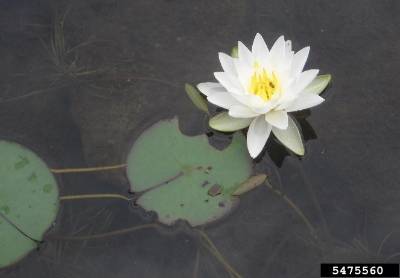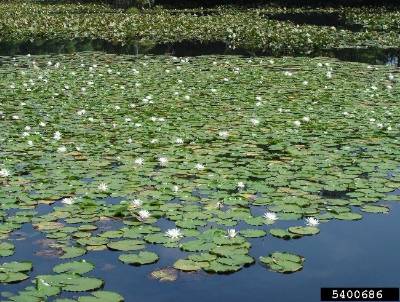Fragrant waterlily (Nymphaea odorata)
Download weed post on Fragrant waterlily (Nymphaea odorata) as PDF (includes word puzzle)

Rob Routledge, Sault College, bugwood.org
Introduction
Fragrant waterlily is a floating, aquatic perennial plant that grows in lakes, ponds, and slow-moving streams. Its nativity is questionable: some sources indicate it is native to all of North America while others indicate it is native to eastern North America and considered introduced or naturalized in western regions of the continent where it sometimes exhibits invasive behavior. The first record of fragrant waterlily in the northwestern United States was in 1933 in Pierce County, WA, and it was reported in Missoula County, MT, soon after in 1937. Fragrant waterlily is listed as a noxious weed in Washington.

Graves Lovell, AL Dept. Cons and Nat. Resources, bugwood.org
Identification and biology
As the name implies, fragrant waterlily has sweet-scented flowers that are white to pink and very eye-catching. Flowers are 3 to 5 inches wide with broad petals that curve lengthwise to form a slight channel in the center. The center of each flower has one pistil and is densely packed with bright yellow stamens. Flowers close at night. The floating leaves are 4 to 12 inches wide, glossy, heart-shaped and broadly rounded. Fragrant waterlily emerges from fleshy rhizomes in early spring and grows through the water column until it reaches the surface where it produces flowers from early summer through early fall. After flowers are pollinated by bees or beetles, they recede underwater by a corkscrew-like curling of the stem. Leiberg’s waterlily (Nymphaea leibergii), native to Montana, is similar in appearance to fragrant waterlily but has fewer petals and stamens, among other small differences.
Habitat and spread
Fragrant waterlily grows in still, relatively shallow (5 to 7 feet) water of ponds, lakes, streams, and ditches. Fragrant waterlily reproduces both by seed and vegetatively, and seeds are dispersed to new areas by floating or dispersal after animals eat the fruits. Available for purchase through the horticulture industry, fragrant waterlily spreads to new areas primarily through intentional plantings in water gardens and ponds.
Impacts
Peer-reviewed literature about the ecology and impacts of fragrant waterlily are generally lacking. Fragrant waterlily is reported to form monotypic stands in some shallow lakes, and these dense populations can impede recreational opportunities like boating, fishing, and swimming. Dense infestations have also been reported to clog irrigation equipment. However, fragrant waterlily has value as an ornamental species in the horticulture industry, and wildlife such as waterfowl, deer, and moose eat the leaves and seeds. Given the species’ questionable nativity in some regions of North America and its perceived beauty and beneficial impacts versus negative impacts, there is a diversity of opinions on fragrant waterlily.
Management options
Preventing movement, either intentional or unintentional, of fragrant waterlily is a management priority for most areas. In areas where fragrant waterlily is established and has demonstrated invasiveness (e.g., some lakes in Washington), mechanical and chemical control options are available. Cutting and hand-pulling all emerging leaves can be effective if regularly repeated. Boat-mounted harvesters or cutters can be used on larger infestations. Aquatic-labeled herbicides containing the active ingredients imazapyr, imazamox, 2,4-D, and glyphosate can also reduce populations of fragrant waterlily. Monitoring after control efforts is important as this species readily reestablishes from the seed bank.
